- Created by Andrew Woods on Jun 16, 2017
Books In Action
- pcdm:Object
- pcdm:Collection
- pcdm:File
Additionally, there are two PCDM relationships that indicate resource membership and file membership:
- pcdm:hasMember
- pcdm:hasFile
The descriptions of these resource types and relationships may be found in the detailed Portland Common Data Model page.
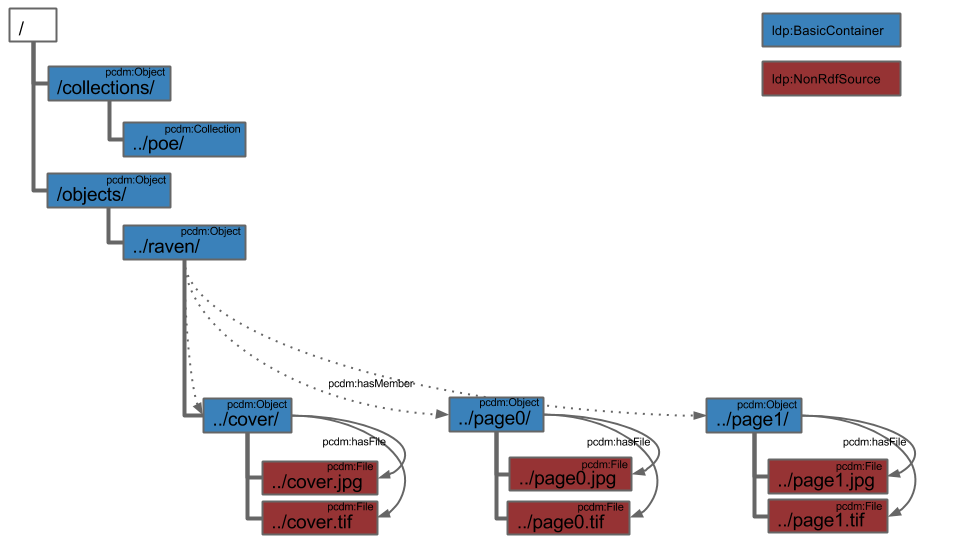
Book - Create DirectContainer
Here we will begin to walk through the mechanics of creating the structures that will facilitate creation of the book and its pages.
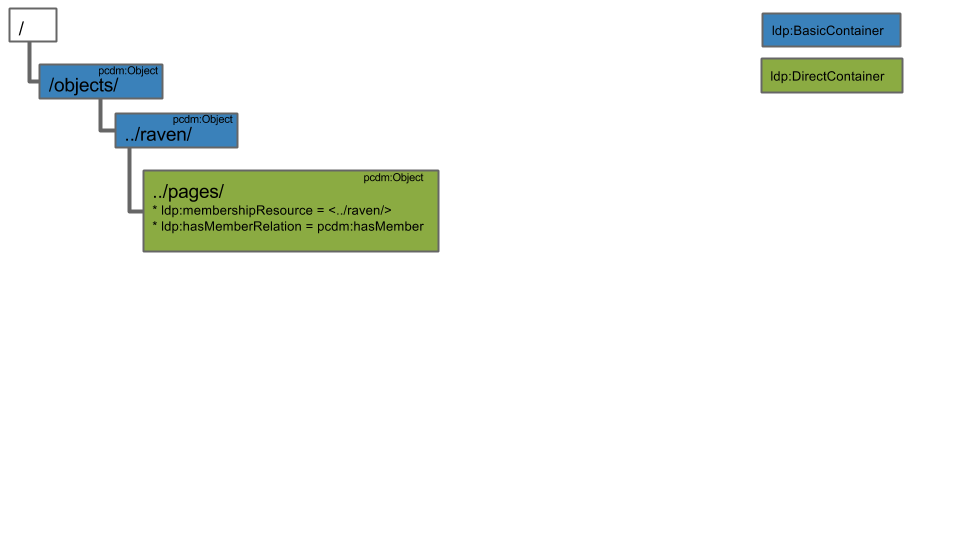
First, create the top-level "objects/" pcdm:Object, which is also an ldp:BasicContainer.
curl -i -XPUT -H"Content-Type: text/turtle" --data-binary @pcdm-object.ttl localhost:8080/fcrepo/rest/objects/
Where "pcdm-object.ttl" follows:
@prefix pcdm: <http://pcdm.org/models#> <> a pcdm:Object .
Second, create the nested "raven/" pcdm:Object, which is also another ldp:BasicContainer.
curl -i -XPUT -H"Content-Type: text/turtle" --data-binary @pcdm-object.ttl localhost:8080/fcrepo/rest/objects/raven/
Lastly, create an ldp:DirectContainer, "pages/" that will facilitate the establishment of relationships between "raven/" and its constituent pages.
curl -i -XPUT -H"Content-Type: text/turtle" --data-binary @ldp-direct.ttl localhost:8080/fcrepo/rest/objects/raven/pages/
Where "ldp-direct.ttl" follows:
@prefix ldp: <http://www.w3.org/ns/ldp#> @prefix pcdm: <http://pcdm.org/models#> <> a ldp:DirectContainer, pcdm:Object ; ldp:membershipResource </fcrepo/rest/objects/raven/> ; ldp:hasMemberRelation pcdm:hasMember .
An ldp:DirectContaner is an LDP construct that activates the creation of certain RDF triples when a new resource is added as a child of this container.
Specifically, when a new resource is added inside of the "pages/" DirectContainer, a new triple on the ldp:membershipResource ("raven/") will be created with the predicate defined by the ldp:hasMemberRelation property ("pcdm:hasMember") and an object that is a reference to the new resource.
The auto-created triple resulting from the addition of a new child resource within "pages/" will take the form:
<http://localhost:8080/fcrepo/rest/objects/raven/> <pcdm:hasMember> <new-resource>
We will see this in action next!
Book - Create Cover
Create a new pcdm:Object, "cover/", that is also an ldp:BasicContainer within the "pages/" DirectContainer.
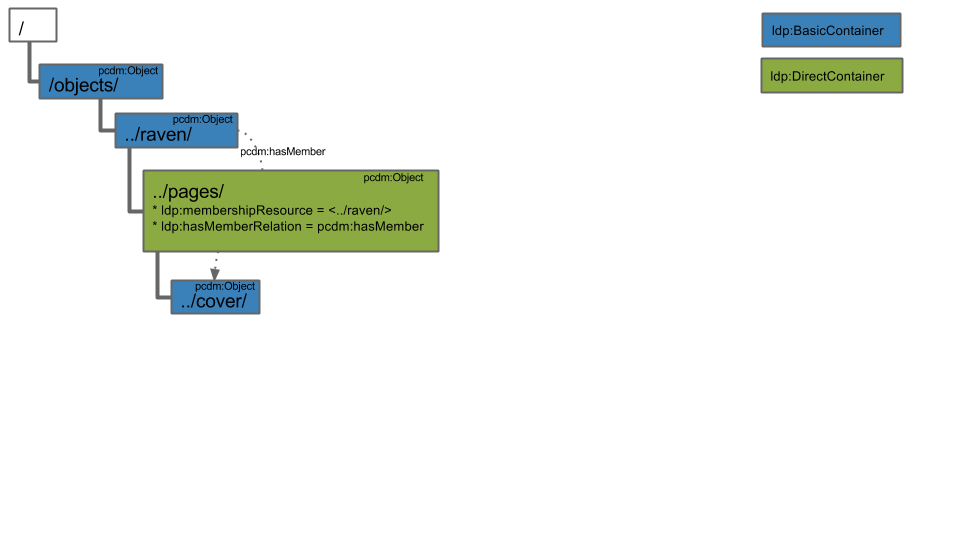
curl -i -XPUT -H"Content-Type: text/turtle" --data-binary @pcdm-object.ttl localhost:8080/fcrepo/rest/objects/raven/pages/cover/
Where "pcdm-object.ttl" follows:
@prefix pcdm: <http://pcdm.org/models#> <> a pcdm:Object .
As described in the previous step, the addition of "cover/" automatically creates the following new triple on "raven/"
<http://localhost:8080/fcrepo/rest/objects/raven/> pcdm:hasMember <http://localhost:8080/fcrepo/rest/objects/raven/pages/cover/>
Restating from the previous step,
- the subject of the triple comes from the "ldp:membershipResource" defined on "pages/"
- the predicate of the triple comes from the "ldp:hasMemberRelation" defined on "pages/", and
- the object of the triple is the new resource ("cover/") that was added to the ldp:DirectContainer ("pages/")
Book - Create Page0
In the same fashion as the previous step, adding "page0/" to the DirectContainer, "pages/" results in a new auto-generated triple on "raven/" of the form:
<http://localhost:8080/fcrepo/rest/objects/raven/> pcdm:hasMember <http://localhost:8080/fcrepo/rest/objects/raven/pages/page0/>
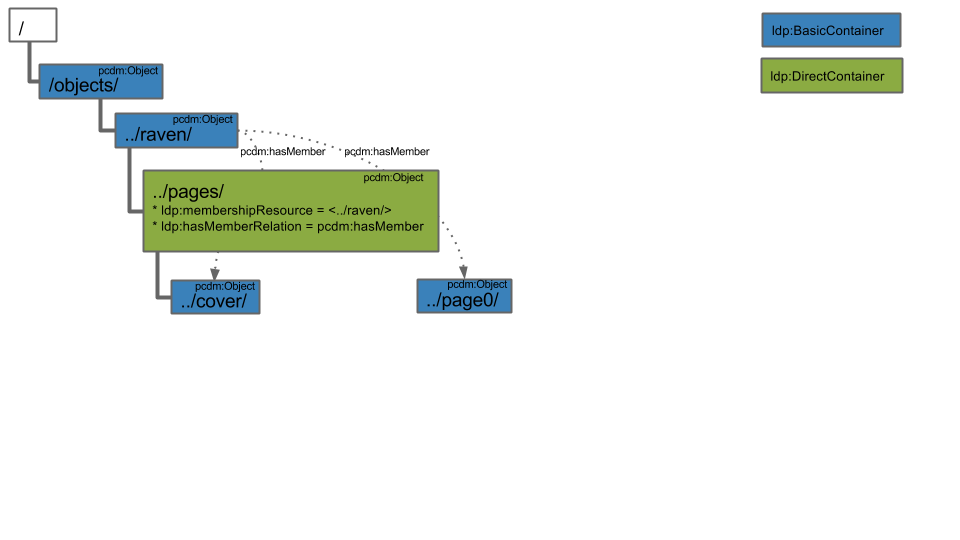
curl -i -XPUT -H"Content-Type: text/turtle" --data-binary @pcdm-object.ttl localhost:8080/fcrepo/rest/objects/raven/pages/page0/
Book - Create Page1
This step in creating the final page, "page1/", follows the same pattern shown in the previous two steps.

curl -i -XPUT -H"Content-Type: text/turtle" --data-binary @pcdm-object.ttl localhost:8080/fcrepo/rest/objects/raven/pages/page1/
Cover - Create DirectContainer
In the same way that we used an ldp:DirectContainer to facilitate the auto-generation of triples linking "raven/" to each of the pages, now use the same pattern to auto-generate the creation of triples that link each page pcdm:Object to their various file representations.

To begin with, create an ldp:DirectContainer, "files/", which is also a pcdm:Object, as a child of "cover/" as follows:
curl -i -XPUT -H"Content-Type: text/turtle" --data-binary @ldp-cover-direct.ttl localhost:8080/fcrepo/rest/objects/raven/pages/cover/files/
Where "ldp-cover-direct.ttl" follows:
@prefix ldp: <http://www.w3.org/ns/ldp#> @prefix pcdm: <http://pcdm.org/models#> <> a ldp:DirectContainer, pcdm:Object ; ldp:membershipResource </fcrepo/rest/objects/raven/pages/cover/> ; ldp:hasMemberRelation pcdm:hasFile .
Now, any new resource that is added as a child of the DirectContainer "files/" will cause the auto-generation of a new triple on "cover/" that has a predicate of pcdm:hasFile and an object of the new resource.
Cover - Create Files
Once again, we demonstrate the use of LDP in creating PCDM relationships simply as a result of repository interactions.

Add two pcdm:File resources to the DirectContainer, "files/" as follows:
curl -i -XPUT -H"Content-Type: image/jpeg" --data-binary @cover.jpg localhost:8080/fcrepo/rest/objects/raven/pages/cover/files/cover.jpg
Where "cover.jpg" is attached.
If you perform a subsequent HTTP HEAD on this new resource, you will see there is a "Link" header of rel="describedby". Update the RDF metadata of the ldp:NonRdfSource to specify that the resource is a pcdm:File, as follows:
curl -i -XPATCH -H"Content-Type: application/sparql-update" --data-binary @pcdm-file.ru localhost:8080/fcrepo/rest/objects/raven/pages/cover/files/cover.jpg/fcr:metadata
Where "pcdm-file.ru" follows:
PREFIX pcdm: <http://pcdm.org/models#>
INSERT {
<> a pcdm:File
} WHERE {
}
Repeat for the attached TIFF, cover.tif
curl -i -XPUT -H"Content-Type: image/tiff" --data-binary @cover.tif localhost:8080/fcrepo/rest/objects/raven/pages/cover/files/cover.tif curl -i -XPATCH -H"Content-Type: application/sparql-update" --data-binary @pcdm-file.ru localhost:8080/fcrepo/rest/objects/raven/pages/cover/files/cover.tif/fcr:metadata
After creating the two "cover" resources, an HTTP GET on "cover/" will include the two new triples:
<http://localhost:8080/fcrepo/rest/objects/raven/pages/cover/> pcdm:hasFile <http://localhost:8080/fcrepo/rest/objects/raven/pages/cover/files/cover.jpg> <http://localhost:8080/fcrepo/rest/objects/raven/pages/cover/> pcdm:hasFile <http://localhost:8080/fcrepo/rest/objects/raven/pages/cover/files/cover.tif>
Once again,
- the subject of the triple comes from the "ldp:membershipResource" defined on "files/"
- the predicate of the triple comes from the "ldp:hasMemberRelation" defined on "files/", and
- the object of the triple is the new resource ("cover.jpg" or "cover.tif") that was added to the ldp:DirectContainer ("files/")
Page0 - Create DirectContainer
Here we repeat the exact steps as for the "cover/" above, but for "page0/".
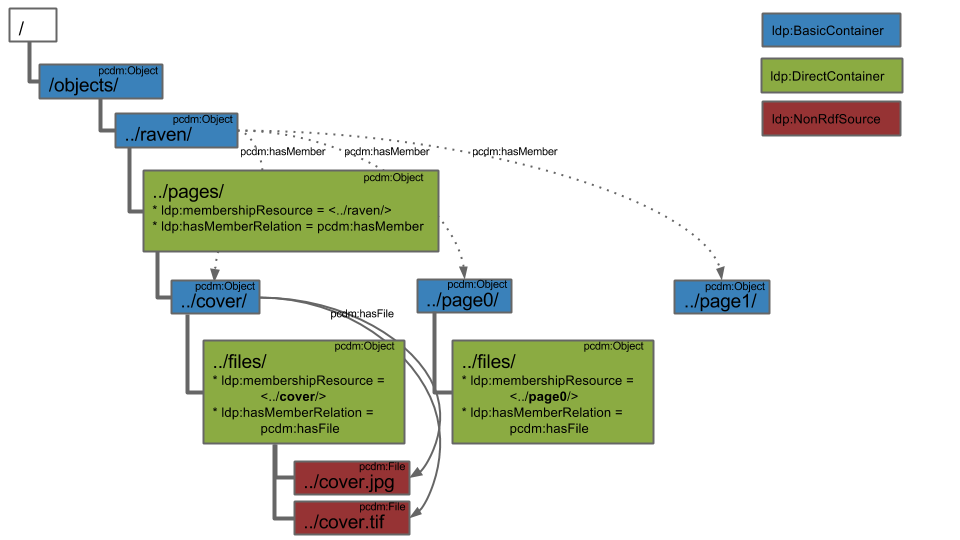
curl -i -XPUT -H"Content-Type: text/turtle" --data-binary @ldp-page0-direct.ttl localhost:8080/fcrepo/rest/objects/raven/pages/page0/files/
Where "ldp-page0-direct.ttl" follows:
@prefix ldp: <http://www.w3.org/ns/ldp#> @prefix pcdm: <http://pcdm.org/models#> <> a ldp:DirectContainer, pcdm:Object ; ldp:membershipResource </fcrepo/rest/objects/raven/pages/page0/> ; ldp:hasMemberRelation pcdm:hasFile .
Page0 - Create Files
Here we add the attached page0 files (page0.jpg and page0.tif) to the newly created DirectContainer.
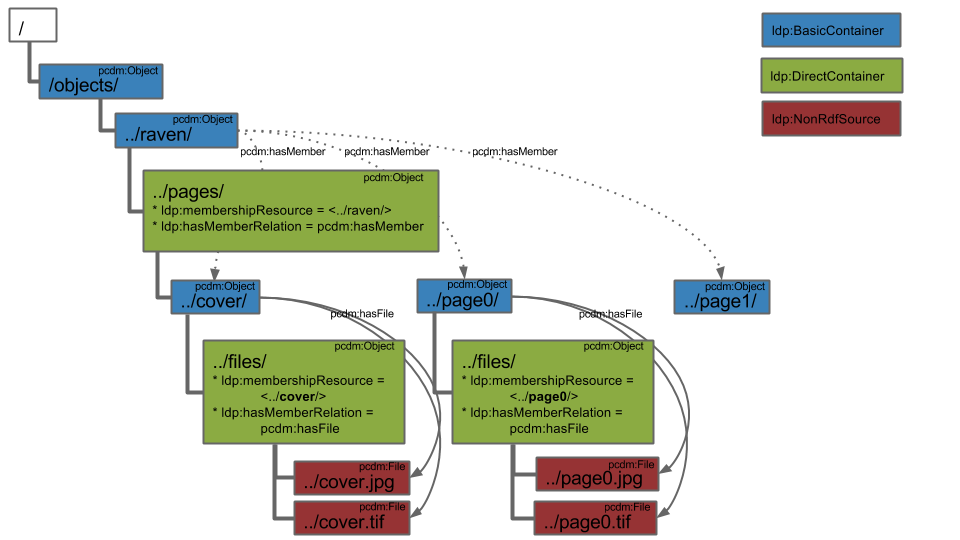
curl -i -XPUT -H"Content-Type: image/jpeg" --data-binary @page0.jpg localhost:8080/fcrepo/rest/objects/raven/pages/page0/files/page0.jpg curl -i -XPUT -H"Content-Type: image/tiff" --data-binary @page0.tif localhost:8080/fcrepo/rest/objects/raven/pages/page0/files/page0.tif
Followed by assigning the type of pcdm:File to the respective RDF Sources found in the "Link; rel=describedby" header of each of the ldp:NonRdfSources.
curl -i -XPATCH -H"Content-Type: application/sparql-update" --data-binary @pcdm-file.ru localhost:8080/fcrepo/rest/objects/raven/pages/page0/files/page0.jpg/fcr:metadata curl -i -XPATCH -H"Content-Type: application/sparql-update" --data-binary @pcdm-file.ru localhost:8080/fcrepo/rest/objects/raven/pages/page0/files/page0.tif/fcr:metadata
Where "pcdm-file.ru" follows:
PREFIX pcdm: <http://pcdm.org/models#>
INSERT {
<> a pcdm:File
} WHERE {
}
Page1 - Create DirectContainer
Here we repeat the exact steps as for the "page0/" above, but for "page1/".

curl -i -XPUT -H"Content-Type: text/turtle" --data-binary @ldp-page1-direct.ttl localhost:8080/fcrepo/rest/objects/raven/pages/page1/files/
Where "ldp-page1-direct.ttl" follows:
@prefix ldp: <http://www.w3.org/ns/ldp#> @prefix pcdm: <http://pcdm.org/models#> <> a ldp:DirectContainer, pcdm:Object ; ldp:membershipResource </fcrepo/rest/objects/raven/pages/page1/> ; ldp:hasMemberRelation pcdm:hasFile .
Page1 - Create Files
Finally, we add the attached page1 files (page1.jpg and page1.tif) to the newly created DirectContainer.
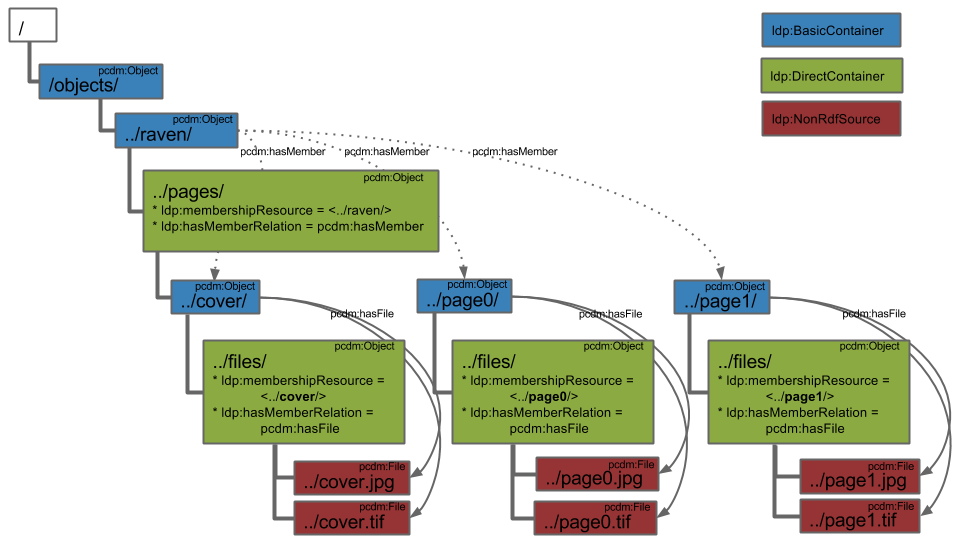
curl -i -XPUT -H"Content-Type: image/jpeg" --data-binary @page1.jpg localhost:8080/fcrepo/rest/objects/raven/pages/page1/files/page1.jpg curl -i -XPUT -H"Content-Type: image/tiff" --data-binary @page1.tif localhost:8080/fcrepo/rest/objects/raven/pages/page1/files/page1.tif
Followed by assigning the type of pcdm:File to the respective RDF Sources found in the "Link; rel=describedby" header of each of the ldp:NonRdfSources.
curl -i -XPATCH -H"Content-Type: application/sparql-update" --data-binary @pcdm-file.ru localhost:8080/fcrepo/rest/objects/raven/pages/page1/files/page1.jpg/fcr:metadata curl -i -XPATCH -H"Content-Type: application/sparql-update" --data-binary @pcdm-file.ru localhost:8080/fcrepo/rest/objects/raven/pages/page1/files/page1.tif/fcr:metadata
Where "pcdm-file.ru" follows:
PREFIX pcdm: <http://pcdm.org/models#>
INSERT {
<> a pcdm:File
} WHERE {
}
Book - Conclusion
Using LDP in conjunction with PCDM terms, we have created a book, "raven/", with its constituent pages and their file representations.
- No labels